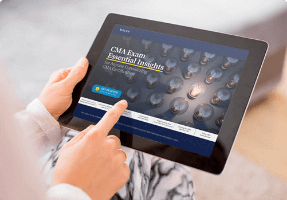CMA Salary Guide

CMA Salary Quick Facts
- CMAs benefit from better job opportunities, increased earning potential, and global appeal
- Globally, CMAs earn 21% more in total compensation than non-CMAs
- CMAs in the Americas earn 25% more in total compensation than non-CMAs
- CMAs are 72% more likely to be CFOs than non-CMAs
- CMAs in lower management earn 19% more in median salary than non-CMAs
- 69% of CMAs agree that career advancement is a benefit of earning the CMA designation
- Dual CMA and CPA holders earn 38% more in median total compensation than those with neither certification
How Does a CMA Serve the Accounting Industry?
Certified Management Accountants are the strategic thinkers of the accounting industry. They use their specialized understanding of financial accounting and strategic business management to explain the financial implications of different business decisions or investments and also help manage risk.
CMAs’ advanced education helps them contribute to businesses in the following areas:
- Performance management
- Cost management
- Risk management
- Financial analysis
- Decision-making support
- And more
Positions Held by CMAs
Certified Management Accountants enjoy increased career mobility and have skills that are relevant to many industries and at different levels of business.
Career paths for CMAs (from entry-level to advanced leadership) include:
- Managerial Accountant
- Financial Analyst
- Financial Planner
- Private Accountant
- Cost Accountant
- Financial Risk Manager
- Corporate Controller
- Chief Financial Officer (CFO)
Having a CMA certification increases your chances of moving up in a company. Compared to their non-CMA counterparts,
- CMAs are 73% more likely to be directors;
- CMAs are 72% more likely to be CFOs; and
- CMAs are 66% more likely to be finance managers.
Plus, 69% of CMAs agree that career advancement is a benefit of earning the CMA designation.
CMA Salary vs. Non-CMA Salary
Certified Management Accountants are highly coveted for their unique skills. Because of this, they earn more than their non-credentialed peers.
CMAs earn 24% more in total compensation in the Americas than non-CMAs ($163,932 median total compensation vs. $131,770). The CMA has great power to increase earning potential worldwide
Globally, CMAs earn 21% more in total compensation than non-CMAs.
CMA Compensation By Region
| Region | Base Salary (Mean) | Total Compensation (Mean) | CMA Premium | |||
|---|---|---|---|---|---|---|
| Non-CMA | CMA | Non-CMA | CMA | Base Salary | Total Compensation | |
| Americas | $114,190 | $137,137 | $131,770 | $163,932 | 20% | 24% |
| Asia Pacific | $33,895 | $37,600 | $39,893 | $45,475 | 11% | 14% |
| Europe | $79,238 | $115,014 | $95,093 | $136,277 | 45% | 43% |
| Middle East/Africa/India | $26,740 | $37,222 | $32,209 | $44,803 | 39% | 39% |
| All | $61,730 | $72,549 | $72,102 | $86,955 | 39% | 21% |
Source: Institute of Management Accountants (IMA) 2023 Global Salary Survey
CMAs enjoy these higher salaries no matter their level in a company. CMAs in lower management earn 19% more in median base salary than non-CMAs in a similar position.
CMA Certification Salary vs. CPA Licensure Salary
In the U.S., professionals who are CMA (Certified Management Accountant) or CPA (Certified Public Accountant)-certified earn more than those who hold neither designation. And holding both increases earning potential even more.
When compared to those without the CMA or the CPA designations,
- CMA holders earn 20% more in median total compensation;
- CPA holders earn 27% more in median total compensation; and
- Dual CMA and CPA holders earn 38% more in median total compensation.
Certification Effects on Median Salary
| Region | Neither Certification | CMA-Only | CPA-Only | CMA and CPA |
|---|---|---|---|---|
| Americas | $99,375 | $120,000 | $126,274 | $137,800 |
| Asia Pacific | $26,030 | $24,763 | $27,600 | $32,164 |
| Europe | $69,979 | $93,644 | $57,063 | $108,660 |
| Middle East/Africa/India | $12,093 | $16,000 | $36,333 | $40,029 |
| All | $36,417 | $41,272 | $91,806 | $99,500 |
Source: IMA 2023 Global Salary Survey
To learn more about the differences between the CMA and CPA designations, visit our CMA vs. CPA resource page.
CMA Salary by Region
Salaries for Certified Management Accountants vary by local and global region, but CMAs always earn more than non-CMAs. As mentioned earlier, CMAs worldwide earn 21% more in total compensation than non-CMAs.
| Region | Base Salary ($) | Total Compensation ($) | ||
|---|---|---|---|---|
| Mean | Median | Mean | Median | |
| Americas | $129,961 | $120,000 | $153,874 | $132,000 |
| Asia Pacific | $36,985 | $26,092 | $44,548 | $29.686 |
| Europe | $104,369 | $90,661 | $124,024 | $98,298 |
| Middle East/Africa/India | $32,878 | $16,000 | $39,583 | $19,200 |
| All | $69,427 | $45,873 | $82,670 | $54,398 |
Source: IMA 2023 Global Salary Survey
Increases to the CMA Salary
CMA (Certified Management Accountant) salaries continue to rise, and even during the COVID-19 pandemic, most CMAs reported their compensation either increasing or remaining the same.
More and more professionals are getting CMA certified every year, and it’s the fastest-growing global certification. The CMA is the “gold standard” of management accounting certifications, and international companies know the value of professionals with highly specific skills in financial accounting, strategic management, risk management, and decision-making.
How to Tell If Your CMA Salary Is a Competitive Offer
Your Certified Management Accountant salary will depend on a variety of factors, such as:
- Position
- Years of Experience
- Education
- Region
Knowing how each of these factors affects your earning potential will help you evaluate whether your CMA salary is competitive. So, let’s examine how these factors affect accounting professionals in the U.S.
CMA Median Salary Premiums by Age
| Age Group | Non-CMA Median Base Salary | CMA Median Base Salary | CMA Premium |
|---|---|---|---|
| 58 or Older (Baby Boomer +) | $125,000 | $140,000 | 12% |
| 43-57 (Gen X) | $91,000 | $100,025 | 10% |
| 27-42 (Millennial) | $32,675 | $38,856 | 19% |
| 26 or Younger (Gen Z) | $7,860 | $11,100 | 41% |
Total Median Compensation by Management Level
| Management Level | Americas | Asia Pacific | Europe | Middle East/Africa/India | All |
|---|---|---|---|---|---|
| Top Management | $195,000 | $68,787 | $191,988 | $57,225 | $135,000 |
| Senior Management | $150,000 | $50,734 | $116,273 | $53,885 | $125,000 |
| Middle Management | $122,000 | $34,394 | $93,978 | $24,582 | $49,867 |
| Lower Management/Entry-Level | $92,030 | $18,844 | $61,276 | $10,892 | $22,873 |
| Academic Position in College/University | $117,200 | $21,711 | $72,105 | $13,318 | $72,737 |
Source: IMA 2023 Global Salary Survey
Being armed with this information and the Annual Salary Calculator helps you identify whether you are getting a fair offer regardless of gender, age, or region.
How to Become a CMA
Becoming a CMA requires obtaining a minimum level of education and work experience and passing the CMA exam. These requirements are known as the 3 E’s (and we’ve added a fourth E).
- Education – earn a bachelor’s degree or related professional certification
- Experience – have at least 2 years of continuous work experience in management accounting or financial management
- Exam – pass both parts of the CMA exam
- Ethics – adhere to the IMA’s Statement of Ethical Professional Practice
CMAs must also complete 30 hours of Continuing Professional Education (CPE) each year to maintain certification.
The easiest way to complete the third E (passing the CMA exam), is to enlist the help of a results-driven CMA review course. UWorld CMA Courses help you pass the exam the first time with tools like a personalized study schedule, the most practice questions on the market, and leading instructors like Monte Swain.
CMA Salary – Frequently Asked Questions (FAQs)
Here are quick answers to some frequently asked questions about earning the CMA credential.
- A Certified Management Accountant (CMA) is a business professional who has expertise in financial accounting and strategic management. CMAs must pass two exams, meet education and professional experience requirements, and adhere to the IMA’s ethics standards.
- Both exams are challenging, but the CMA exam does have a slightly lower pass rate (about 45%) than the CPA Exam (about 50%). The CMA exam comprises 8 hours of testing split between 2 exam sections. And the CPA Exam consists of 16 hours of testing split between 4 exam sections.
- The CMA designation is in-demand and generally has broader appeal if you’re looking to pursue a corporate accounting leadership position, but the CFA charter is still beneficial for those who want to pursue an advanced career in investment management.
- The CMA exam has about a 45% pass rate and requires CMA candidates to display mastery in management accounting. Get more information about the CMA exam on our expansive collection of CMA resource pages.
- A Certified Management Accountant (CMA) is an accounting professional with a global certification that endorses their expertise in financial accounting and strategic management. A Certified Public Accountant (CPA) is an accounting professional with a U.S. license that authorizes them to conduct audit levels and sign tax and regulatory filings. CMAs typically work for private businesses and CPAs typically work in public accounting.
- Dual certification can be greatly beneficial, especially for CPAs. Having dual certification differentiates you from your colleagues, allows you to better serve your clients and employer, and makes you eligible for an even higher salary (38% higher than the median income to be exact). Read more about the reasons to earn both your CPA and CMA.
Related Articles
We use cookies to learn how you use our website and to ensure that you have the best possible experience.
By continuing to use our website, you are accepting the use of cookies.
Learn More



